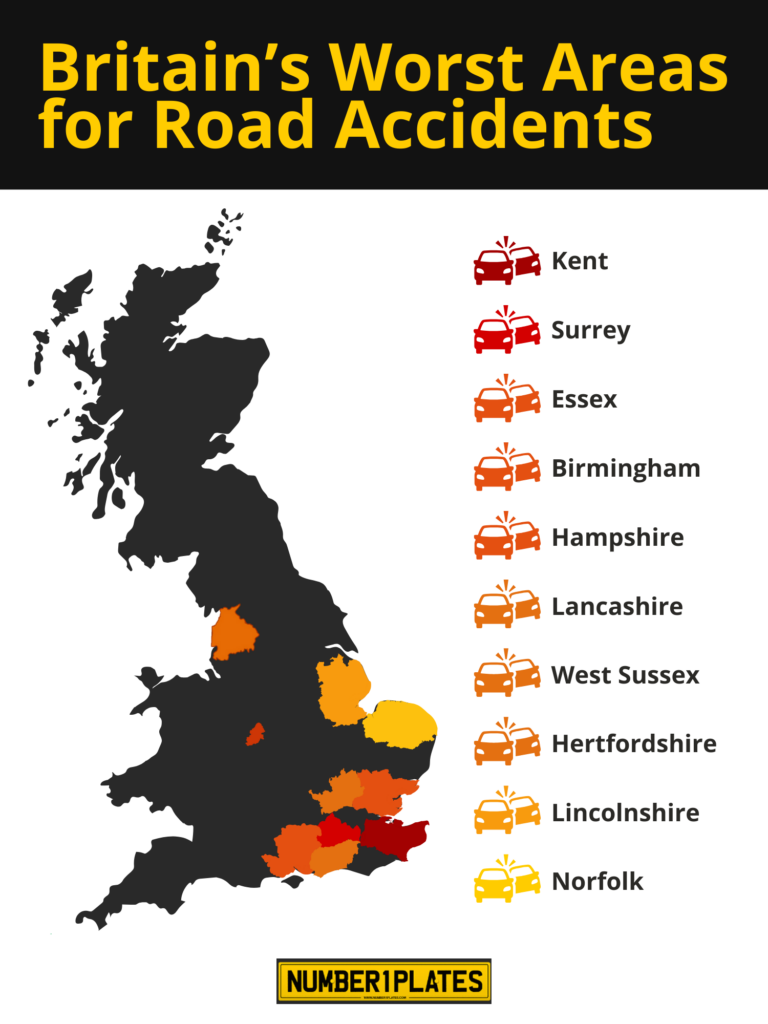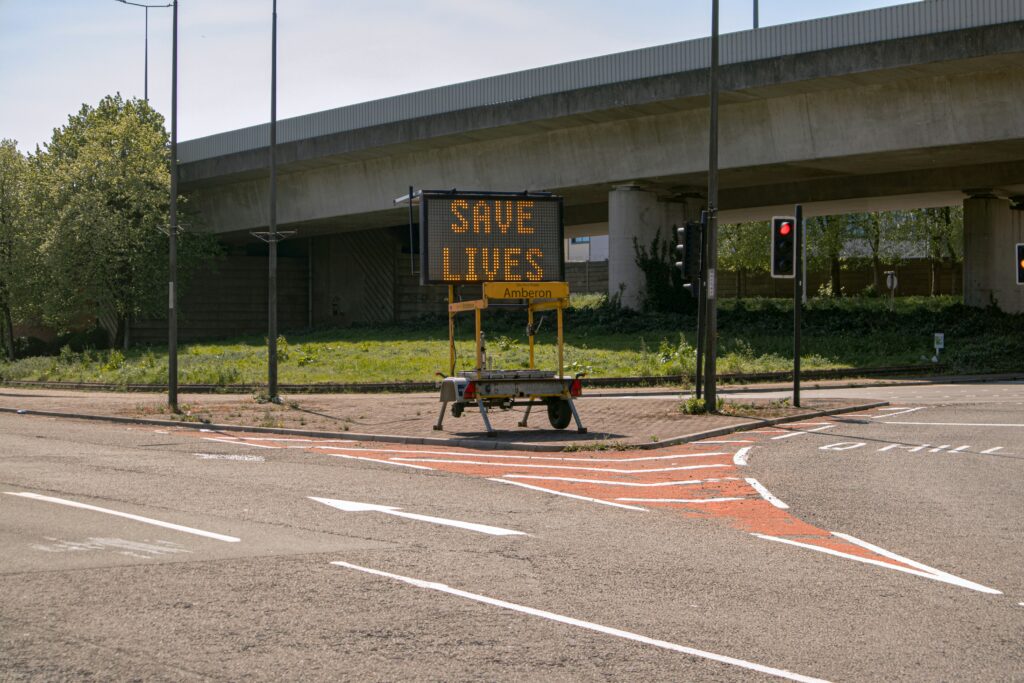Revealed: Britain’s Worst Areas for Road Accidents
Great Britain saw an estimated 133,443 road collisions in 2023, showing a decline of just 4% since 2022. To help raise awareness of road safety, we looked at reported road accidents across Britain in the last five years, compiling a list of the top five worst areas for traffic collisions, and also the areas with the least amount. We’ve also concluded the research with a range of easy tips and advice to help you stay safe while driving.
The areas that see the most road accidents
Kent revealed as having the most dangerous roads in Britain
With 20,473 recorded accidents from 2019 to 2023, we found Kent to have the most unsafe roads in Britain! Kent’s roads have several factors that may contribute to this statistic — the A254 and A252 have been cited as some of the worst.
This area has an extensive network of rural roads, which are often narrow, poorly lit, and prone to sharp bends, which creates hazardous driving conditions, especially when many are driving at higher speeds on quieter roads.
The county also sees a huge amount of heavy traffic due to its proximity to London and the Port of Dover, which only increases congestion and the risk of accidents. Additionally, a lack of sufficient public transportation, compared to other areas, can lead to a high reliance on cars and further overcrowded roads. All of these elements combined make Kent a particularly perilous region for drivers, pedestrians, and cyclists.
South East England revealed as worst region for road accidents
Surrey and Essex also rank in our top five list of worst areas for road accidents, highlighting significant road safety concerns for the South East of England.
Over the past five years, Surrey has recorded 16,414 accidents, while Essex has reported 13,964. Surrey’s high accident rate can be attributed to its mix of densely populated towns and rural roads, where speeding and poor visibility are common issues. Similar to Kent, the county’s closeness to London and major motorways such as the M25 and A3 increase traffic in Surrey, which in turn leads to more collisions.
Essex also experiences vast volumes of traffic due to its links to key roadways, but it’s also a huge commuter corridor to London. It seems the combination of congested urban areas and risky rural stretches makes both Surrey and Essex dangerous for drivers.
Birmingham is the fourth worst area for road accidents
There were 13,758 road accidents in Birmingham over the last five years, which may be heavily influenced by its extensive road network and heavy traffic. The major urban city faces increased risk when it comes to collisions due to congestion and high pedestrian activity close to busy roads, including the commuting routes of A38, Hagley Road and Leebank Middleway. Another major road, A38 Bristol Road, is officially the worst road in Birmingham for speeding, where 1,655 offences were recorded in the last 12 months.
Hampshire holds fifth place for road accidents
Finalising our list of the five worst areas for road accidents is Hampshire, with 13,624 reported incidents. This result is most likely due to its mix of busy motorways, like the M3, and rural roads where speeding on winding roads is more common. Data from the National Highways’ Strategic Roads User Survey also recently revealed the A27 was the worst major Hampshire road due to constant roadworks leading to congestion.
These statistics emphasise the desperate need for tailored road safety measures in both urban and rural areas to address separate risks drivers face in each environment.
Britain’s areas with the lowest amount of road accidents
We also looked into the areas with the least amount of road accidents and found that the Isles of Scilly was the area with the least incidents, with just five recorded in the last five years. Although this could suggest that the Isles of Scilly is the safest place for driving in Britain, other elements could also add to its impressively low statistic.
With its population of just 2,285 and limited road infrastructure, the remote archipelago off the Cornish coast will naturally see less traffic compared to Kent and Surrey. However, the island’s quiet roads are predominantly used for local transport, with lower speed restrictions, making critical accidents rare.
Joining the Isles of Scilly on our list of roads with low accident numbers are other remote locations such as the Shetland Islands, Orkney Islands and Comhairle nan Eilean Siar, making both Scotland and Wales the safest countries in Britain for road safety. These areas all have similar characteristics — small, close-knit communities and fewer vehicles on the roads — leading to significantly lower accident rates compared to more urbanised areas.
What are the top causes of road accidents in Britain?
According to a GOV.UK police report, human error remains the most significant factor in road collisions. The main cause, with 218,489 accidents reported over the last five years in Great Britain, is ‘driver or rider error or reaction’ which suggests that misjudgements on the roads and delayed responses are critical risks to drivers.
The report also cited ‘failing to look properly’ as another leading cause, accounting for 120,542 incidents, which could relate to busy areas where many drivers overlook other road users like pedestrians or cyclists.
Contributing to 84,234 accidents over the last five years was ‘behaviour or inexperience’, which is no surprise when many inexperienced drivers may make risky decisions that have a high likelihood of causing crashes.
Other notable causes were ‘injudicious actions’ and ‘careless, reckless, or hurried driving’. These figures emphasise the importance of attentive, cautious driving and proper training to reduce the occurrence of so many avoidable accidents in the future.
How to steer clear of collisions whilst driving
Staying safe and aware whilst driving is the main way to reduce the risk of road accidents. To help people stay safe on the roads, we have compiled tips on how to be safe behind the wheel and ensure you stay away from avoidable road accidents.
Reviewing and planning your journey
Planning your journey and making note of roads ahead can help keep drivers safe, especially if you know you’re visiting a busy area. Having knowledge and awareness of your route may help you dodge high-traffic areas or inform you of when you need to be hyper-alert to get to your destination safely. You might also want to look into speed restrictions on your route, or if the conditions are rainy, icy or foggy, adjust your speed to keep safe.
Stay focused and avoid distractions
It is important to keep your attention fully on the road at all times. Avoid distractions like looking at your mobile phone, adjusting your music, or eating while driving. Sometimes even a momentary lapse in concentration can lead to an accident. If you’re feeling tired, take regular breaks or avoid travelling altogether. Putting your windows down, blasting some cold air or turning your music up are a few ways you can keep yourself alert when feeling weary on long journeys.
Always check your surroundings
Many accidents occur because drivers fail to keep an eye on their vicinity. Make sure to regularly check your mirrors and blind spots, avoid tailgating and always be aware of other road users like cyclists, motorcyclists, and pedestrians who are more vulnerable in traffic.
Stay calm and avoid careless driving
If you’re in a hurry or frustrated, resist the urge to make spontaneous decisions like speeding, or engaging in risky manoeuvres. Remaining calm and patient is key to avoiding dangerous situations on the road. It may seem obvious but never drive under the influence of alcohol or drugs, as these will impair your judgment and reaction times more than you may realise.
Human error, poor road conditions, and high traffic volumes are key factors behind most accidents in Britain. High-risk areas like Kent, Surrey, and Essex face unique challenges due to traffic congestion and hazardous road conditions, while safer areas like the Isles of Scilly demonstrate how lower traffic volumes and careful driving can prevent accidents. Yet, road safety is still within our control — whether you’re navigating hazardous rural roads or congested urban streets, staying focused, planning ahead, and always checking your surroundings can significantly reduce the risk of an accident.
Ultimately, with these proactive measures, we can all contribute to making Britain’s roads safer for everyone.
Methodology:
Gov.uk Reported road casualties Great Britain, provisional results: 2023 –https://www.gov.uk/government/statistics/reported-road-casualties-great-britain-provisional-results-2023/reported-road-casualties-great-britain-provisional-results-2023#:~:text=In%20reported%20road%20collisions%20in,of%203%25%20compared%20to%202022
CrashMap – https://www.crashmap.co.uk/



 100% Road Legal
100% Road Legal Express Delivery
Express Delivery








